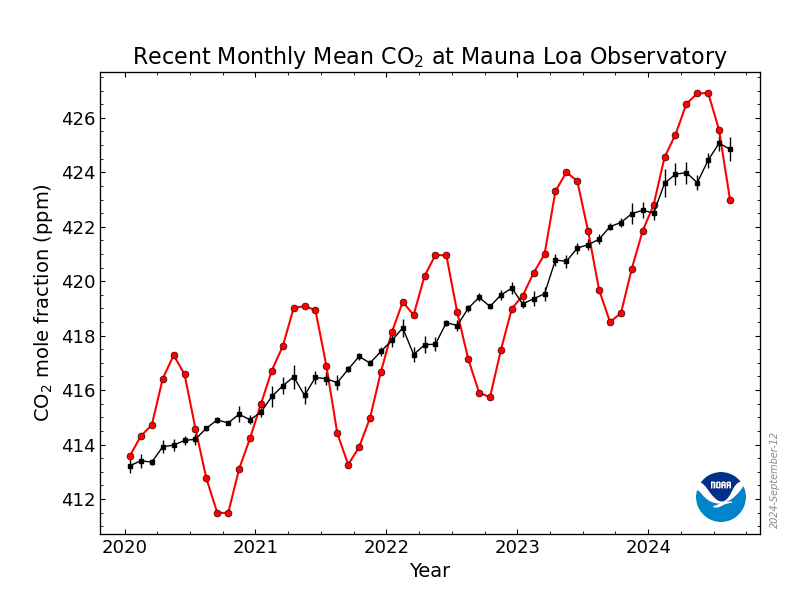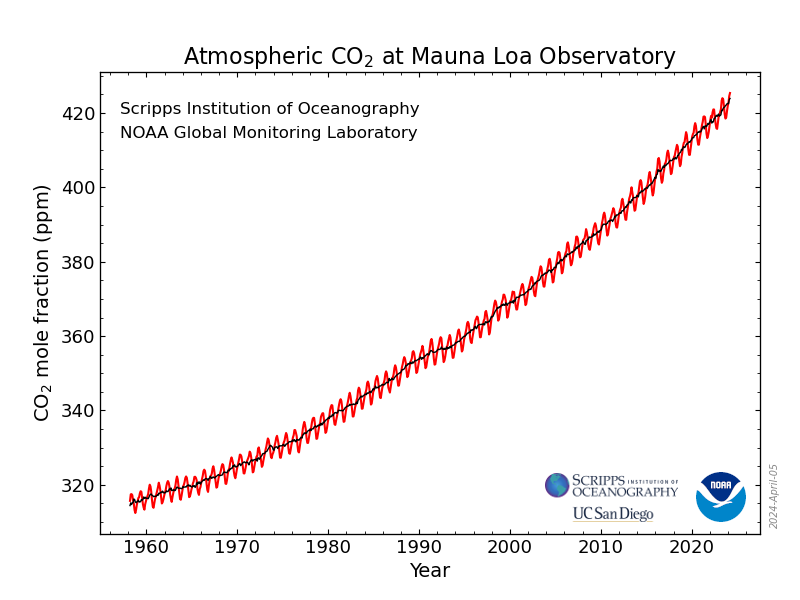Trends in CO2, CH4, N2O, SF6

Trends in Atmospheric Carbon Dioxide (CO2)
Monthly Average Mauna Loa CO2
| November 2025: | 426.46 ppm |
| November 2024: | 423.85 ppm |
The graphs show monthly mean carbon dioxide measured at Mauna Loa Observatory, Hawaii. The carbon dioxide data on Mauna Loa constitute the longest record of direct measurements of CO2 in the atmosphere. They were started by C. David Keeling of the Scripps Institution of Oceanography in March of 1958 at a facility of the National Oceanic and Atmospheric Administration [Keeling, 1976]. NOAA started its own CO2 measurements in May of 1974, and they have run in parallel with those made by Scripps since then [Thoning, 1989].
The last five complete years of the Mauna Loa CO2 record plus the current year are shown in the first graph. The full record of combined Scripps data and NOAA data is shown in the second graph. Every monthly mean is the average of daily means, which are in turn based on hourly averages, but only for those hours during which “background” conditions prevail (see gml.noaa.gov/ccgg/about/co2_measurements.html for more information).
The red lines and symbols represent the monthly mean values, centered on the middle of each month. The black lines and symbols represent the same, after correction for the average seasonal cycle. The latter is determined as a moving average of SEVEN adjacent seasonal cycles centered on the month to be corrected, except for the first and last THREE and one-half years of the record, where the seasonal cycle has been averaged over the first and last SEVEN years, respectively.
The vertical bars on the black lines of the first graph show the uncertainty of each monthly mean based on the observed variability of CO2 in different weather systems as they go past the top of Mauna Loa. This is manifest in the deviations of daily means from a smooth curve that follows the seasonal cycle [Thoning, 1989]. We take into account that successive daily means are not fully independent, the CO2 deviation on most days has some similarity to that of the previous day. If there is a missing month, its interpolated value is shown in blue.
The last year of data are still preliminary, pending recalibrations of reference gases and other quality control checks. Data are reported as a dry air mole fraction defined as the number of molecules of carbon dioxide divided by the number of all molecules in air, including CO2 itself, after water vapor has been removed. The mole fraction is expressed as parts per million (ppm). Example: 0.000400 is expressed as 400 ppm.
The Mauna Loa data are being obtained at an altitude of 3400 m in the northern subtropics, and may not be the same as the globally averaged CO2 concentration at the surface.


